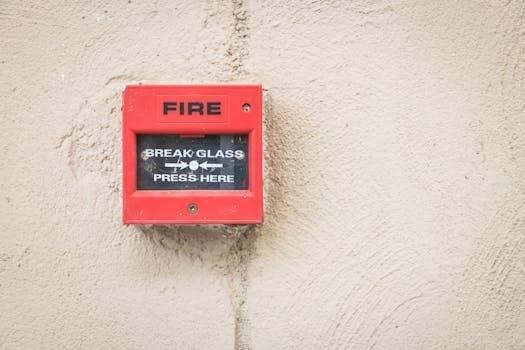Fire Alarm Manual Call Point Sign⁚ An Overview
Fire alarm manual call point signs are mandatory in many buildings. They ensure persons can locate and use a manual call point quickly during emergencies to minimize risks like injuries and damage.
What is a Fire Alarm Manual Call Point Sign?
A fire alarm manual call point sign is a crucial safety component. It indicates the precise location of a manual call point. These signs are essential for any building with a fire alarm system‚ and are often mandatory. They enable occupants to quickly identify and activate the fire alarm system in the event of a fire. This minimizes potential injuries and damage. These signs play a vital role in ensuring the safety of everyone within a building. In an emergency‚ a clear and easily visible sign will guide individuals to the nearest manual call point. This allows them to promptly alert others and initiate the necessary fire safety protocols. The signs are often designed with universally recognized symbols and colors‚ such as red and white. This ensures they are easily understood regardless of language or background. Fire action notices should also be posted next to the call point.

Importance of Fire Alarm Manual Call Point Signs
Fire alarm manual call point signs are essential for maintaining building safety. They play a crucial role in facilitating rapid response during fire emergencies. Clear and visible signage ensures that occupants can quickly locate and activate manual call points. This allows them to promptly alert others and initiate fire safety protocols. This reduces the risk of injury and damage. These signs are important because they provide a clear indication of where a fire alarm can be manually triggered. Such signs help to minimise any confusion or delays during an emergency. Well-placed signs ensure that individuals can quickly locate and use a manual call point in an emergency. This can significantly reduce the time it takes to alert the building and emergency services to a fire. This can be especially crucial in saving lives and protecting property.

Regulatory Requirements for Manual Call Point Signs
Adhering to regulatory requirements for manual call point signs is vital for ensuring fire safety and compliance. The Regulatory Reform (Fire Safety) Order 2005 mandates clear signage for manual fire alarm call points. These regulations ensure that occupants can easily locate and use manual call points in emergencies. Compliance with BS 5839 standards is also important‚ dictating sign size and visibility. These standards often require specific colors‚ symbols‚ and dimensions for fire alarm signs. Local building codes and fire safety regulations may impose additional requirements. The absence of proper signage‚ or failure to comply with the applicable regulations‚ can result in penalties. Regular inspections are often conducted to ensure that buildings meet these regulatory standards. Proper sign maintenance and timely replacements are necessary to maintain compliance. Staying informed about current fire safety regulations is crucial for building owners and managers.
Placement and Location Guidelines
Proper placement is essential for manual call point signs. They must be visible along escape routes‚ exits‚ passageways‚ and stairwells. Accessibility is key‚ ensuring quick location during emergencies for all occupants.
Height and Distance Considerations
Regulatory guidelines dictate specific height and distance considerations for manual call point placement. No one should have to travel more than 30 meters to reach a manual call point‚ allowing building occupants to quickly activate the fire alarm system. For disabled residents‚ this distance should be adapted to within 25 meters.
Consider the height at which the call point is installed. The call point should be easily accessible and reachable for all individuals‚ including those with disabilities. These considerations ensure that anyone can activate the alarm system promptly and efficiently.
Adequate spacing between call points ensures comprehensive coverage throughout the building. Proper height and distance placements facilitate swift alarm activation‚ enhancing overall fire safety.
If exit routes are undefined‚ the direct line distance should not exceed 30 meters.
Placement on Each Floor
Fire safety regulations mandate at least one manual call point on each building floor. This requirement ensures comprehensive coverage‚ allowing occupants to trigger the fire alarm system from any location. Strategically placing call points on each floor enhances the building’s overall fire safety.
The call point should be installed on the floor side of an exit door leading to a staircase. This placement ensures that when the alarm is triggered‚ the alarm system activates promptly. Consider the layout of each floor to determine the optimal placement of manual call points.
Ensure visibility and accessibility. Proper placement on each floor facilitates swift alarm activation‚ enhancing overall fire safety. The call point should be mounted visibly along escape and rescue routes. Proper placement on each floor enhances the building’s overall fire safety measures.
Proximity to Exits and Stairwells
Manual call points must be mounted visibly along escape and rescue routes. Optimal locations include exits‚ passageways‚ and stairwells‚ ensuring easy accessibility during emergencies. The strategic placement of these call points is crucial for swift alarm activation and safe evacuation.
According to BS 5839‚ call points should be placed near all exits to facilitate quick alarm triggering. This ensures that individuals evacuating the building can easily activate the fire alarm system‚ alerting others to the danger. The placement of call points near exits and stairwells enhances overall fire safety.
Manual call points should always be installed on the floor side of an exit door leading to a staircase. This ensures that when the alarm is triggered‚ the alarm system activates promptly. Proper placement near exits and stairwells enhances the building’s overall fire safety.
Types of Fire Alarm Manual Call Point Signs
Fire alarm manual call point signs come in various types to suit different needs and environments; Self-adhesive vinyl signs are common‚ designed to help occupants quickly locate a call point in an emergency. Jalite offers such signs‚ ensuring visibility and durability.
Signs also vary in size; larger signs are suitable for corridors or offices‚ ensuring clear visibility. Explosion-proof fire alarm manual call points and signs are available for hazardous environments. These specialized signs meet stringent safety standards.
Additionally‚ call point ID signs are mandatory in many buildings‚ helping people quickly locate and use manual call points. These signs‚ along with Fire Action Notices‚ provide comprehensive information for raising the alarm and ensuring effective emergency response. The variety of signs ensures adaptability.

Maintenance and Inspection of Manual Call Point Signs
Regular maintenance and inspection of manual call point signs are essential for ensuring their effectiveness during a fire emergency. Signs with worn-off text or visible damage must be addressed immediately by building management.
Routine checks should include verifying the sign’s visibility and legibility. Ensure the sign is clean and free from obstructions. Damaged or missing signs should be replaced promptly to maintain clear communication and prevent confusion during emergencies.
Additionally‚ the functionality of the manual call points themselves should be tested periodically to ensure they activate the fire alarm system as intended. Any issues with the call points or their signage must be rectified as soon as possible to guarantee the reliability of the fire alarm system.

What to Do if Signs are Damaged or Missing
If fire alarm manual call point signs are damaged or missing‚ immediate action is crucial. Report the issue to the building’s management or fire safety officer as soon as possible. Damaged signs may be illegible‚ causing confusion during an emergency‚ while missing signs leave occupants unaware of the call point’s location.
In the meantime‚ clearly mark the area where the sign is missing or damaged to prevent confusion. Building management should promptly replace or repair the signs to ensure clear visibility and accessibility of the fire alarm system. Document the report and follow up to ensure the issue is resolved promptly‚ maintaining a safe environment for all occupants.
Functionality of Manual Call Points
Manual call points are crucial devices designed for manual initiation of fire alarm signals. Upon activation‚ a manual call point sends a signal to the fire systems control panel‚ indicating a fire in its immediate area. This triggers the fire alarm throughout the building and initiates fire emergency protocols‚ including alerting the fire brigade.
These devices are designed to meet strict electrical and fire safety standards. Regular testing ensures their reliability during emergencies. The activation process typically involves breaking a glass or pressing a button‚ which sends an immediate alert. Manual call points can also trigger sounders‚ visual alarms‚ and emergency communication systems to facilitate evacuation.
Preventing False Alarms
To prevent accidental triggering of fire alarm notifications‚ especially in sensitive buildings‚ it is recommended to install manual call point covers. These covers reduce misuse and unnecessary alarms from occurring.
Use of Call Point Covers
Call point covers are a simple yet effective solution to prevent false alarms. False alarms can disrupt operations‚ cause unnecessary panic‚ and potentially desensitize occupants to real emergencies. The installation of a protective cover over a manual call point acts as a deterrent. It requires a deliberate action to lift or break the cover before the alarm can be activated.
This additional step can significantly reduce the likelihood of accidental or malicious triggering. Covers are particularly useful in areas prone to accidental activation‚ such as hallways‚ schools‚ and industrial settings. They also help prevent misuse in environments where individuals might tamper with the devices.
Moreover‚ call point covers do not impede legitimate alarm activation when a fire is present. In a real emergency‚ the cover can be quickly bypassed‚ ensuring that the alarm is promptly sounded to alert occupants and initiate the appropriate fire safety protocols. They serve as a practical measure to balance the need for accessible alarms with the prevention of unwanted disruptions.
Integration with Fire Alarm Systems
Manual call points are vital components of a comprehensive fire alarm system‚ working seamlessly with other devices to ensure rapid and effective fire detection and response. When a manual call point is activated‚ it sends a signal to the fire alarm control panel‚ the central hub of the system. The panel then initiates a series of pre-programmed actions‚ such as sounding alarms‚ activating visual warning devices‚ and transmitting signals to a monitoring center or the fire brigade.
The integration of manual call points with the fire alarm system ensures that all occupants are alerted to the danger‚ and emergency services are notified promptly. Modern systems can even pinpoint the exact location of the activated call point‚ enabling first responders to quickly locate the source of the fire. Furthermore‚ integration can include shutting down ventilation systems‚ closing fire doors‚ and controlling elevators to facilitate evacuation and prevent the spread of fire and smoke.
Regular testing and maintenance of the entire integrated system are essential to ensure its reliability and effectiveness in a real emergency.